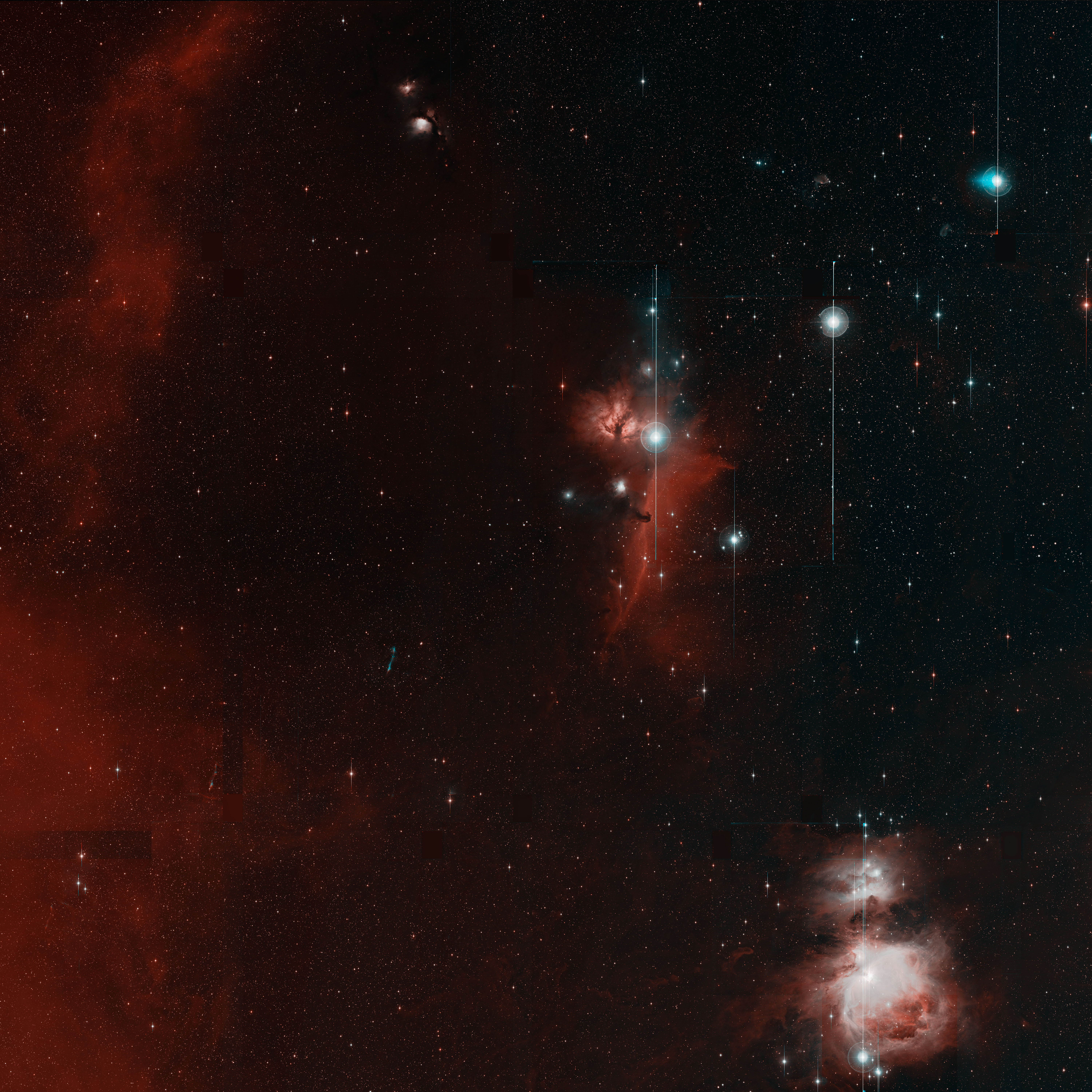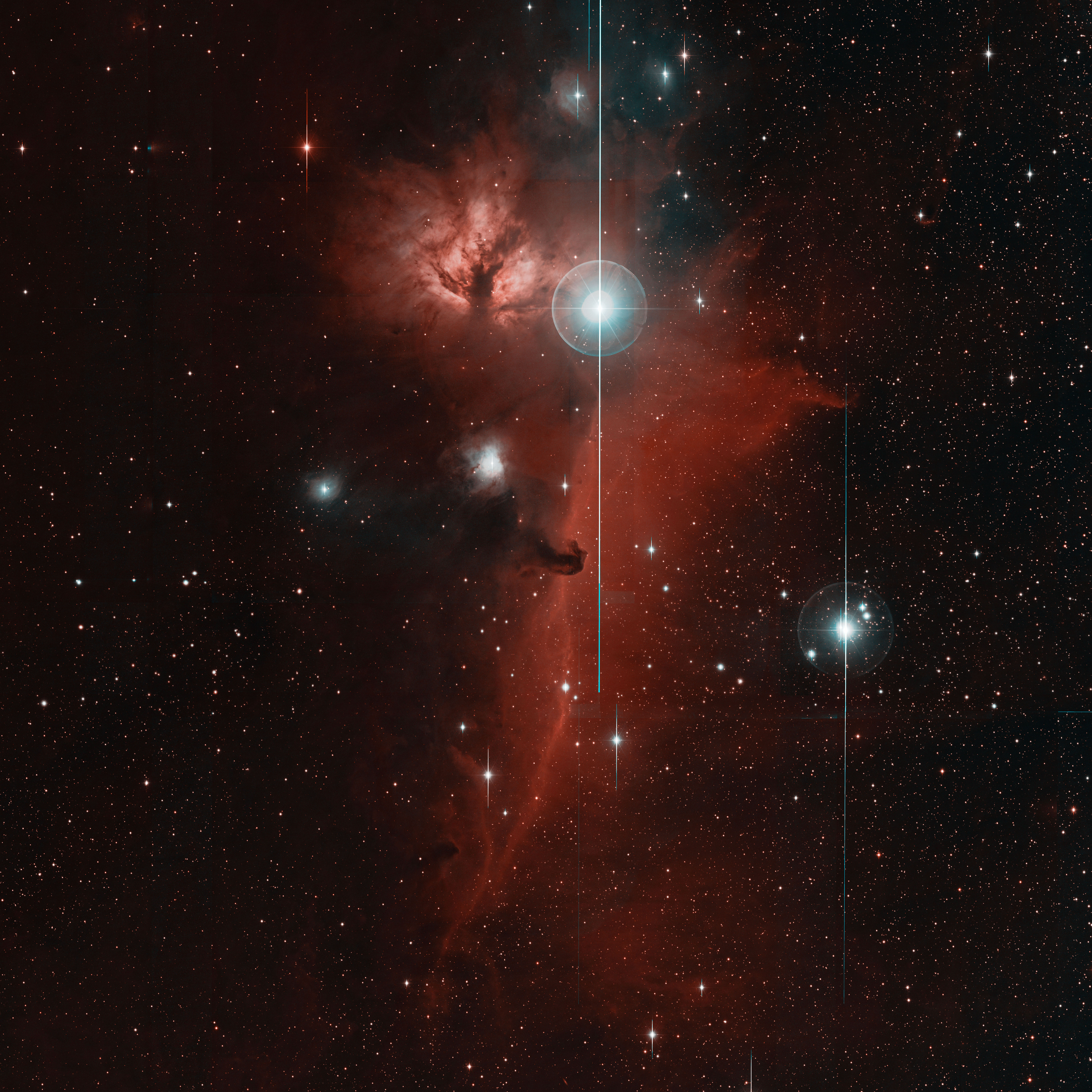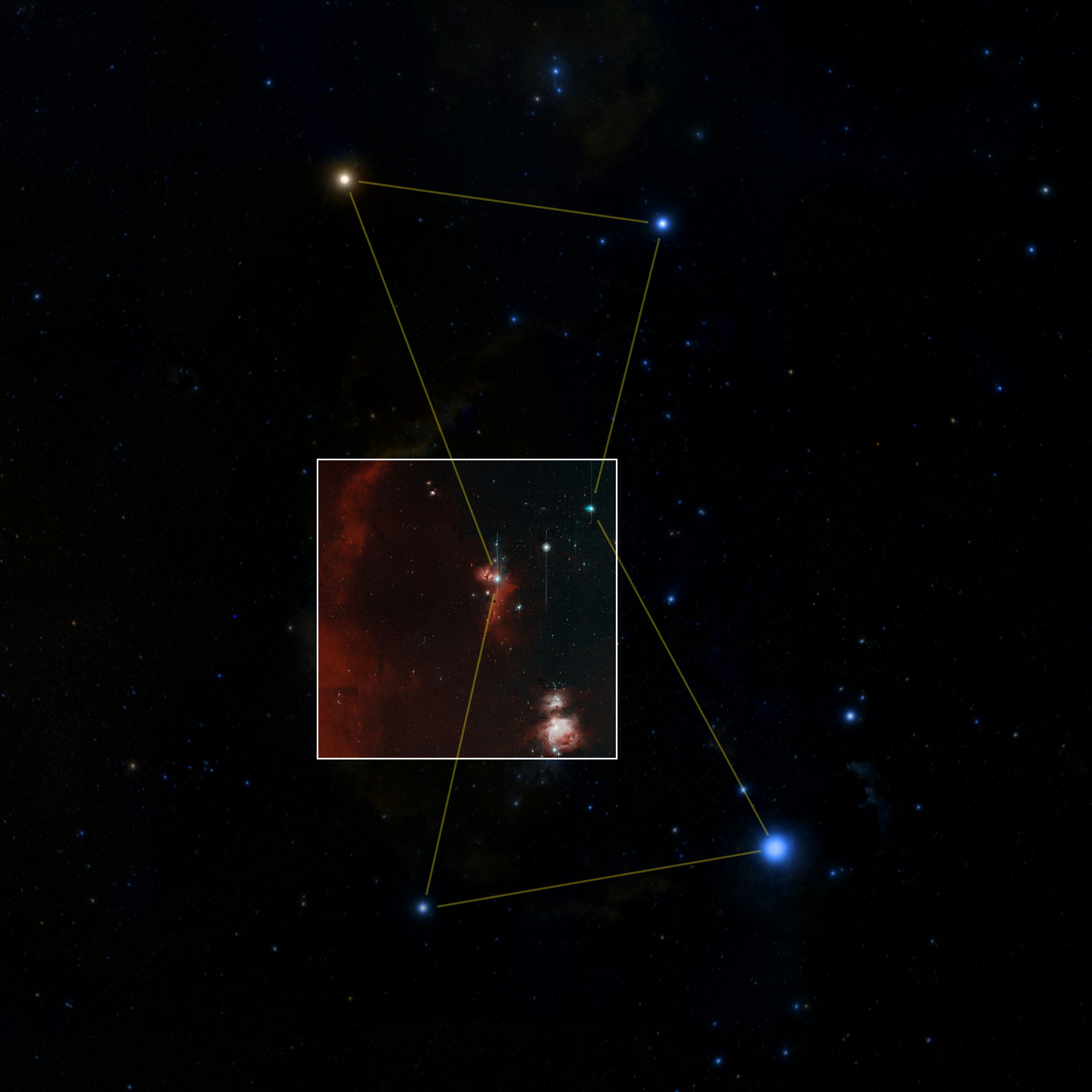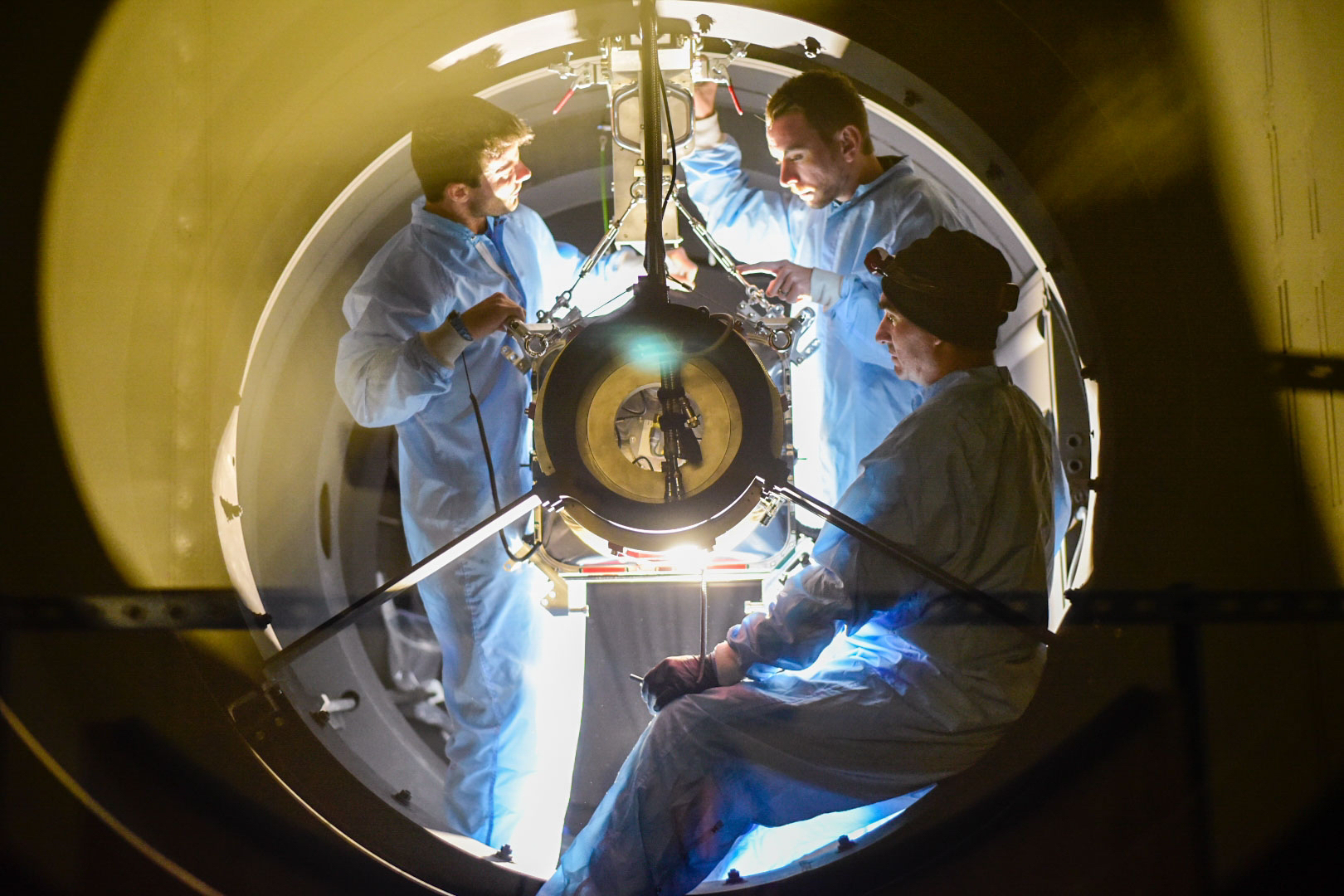New Camera Will Search for Star Explosions and Other Quick Changes in the Cosmos
A powerful new camera that will help scientists search for exploding stars and fast-moving objects in Earth's solar system has captured its first image of the night sky.
The Zwicky Transient Facility (ZTF) is officially up and running at the California Institute of Technology's Palomar Observatoryin the mountains northeast of San Diego. Its primary piece of hardware is a wide-field camera, attached to a 48-inch (122 centimeters) telescope, that can image the entire visible plane of the Milky Way galaxy twice per night and the entire night sky every three nights, according to a statement from Caltech.
The first image from ZTF shows a region of the sky in the constellation Orion that includes the Horsehead Nebula, a star-forming region imaged in glorious detailby the Hubble Space Telescope. But the ZTF camera has a considerably larger field of view compared with Hubble's — each image captures an area on the sky measuring 47 square degrees, or about 247 times the area of the full moon, according to the statement. [The Zwicky Transient Facility in Photos]

Photographing huge areas of the sky extremely quickly is ZTF's primary function. By comparing images of the same region of the sky taken within a few hours or a few days of one another, scientists can look for cosmic objects that are moving or changing in brightness over those short timescales.
Of course, most stars, galaxies, nebulas and other large cosmic objects remain more or less stagnant — in brightness and position — over a few hours or days. But the universe is also full of so-called variable objects (those that change in brightness) and transient objects (that appear to move relatively quickly). These include things like dying stars that explode as supernovasand, in a matter of hours, become exponentially brighter than they were the day before; asteroids that zip through the solar system; black holes that devour entire stars, causing the material from the star to rapidly change in brightness; and pairs of neutron stars, the densest objects in the universe, that mergeand release great bursts of radiation.
"The universe is an extremely dynamic place," Mansi Kasliwal, an assistant professor of astronomy at Caltech and a member of the ZTF team, said in a video from Caltech. Referring specifically to supernovas and other brief eruptions of light, Kasliwal said, "These short-lived explosions — they could last for seconds, for minutes, for months, but [eventually], they disappear on us. And catching these flashes of light, catching these cosmic fireworks, that's what ZTF can uniquely do."

The ZTF science survey, scheduled to run from early 2018 until the end of 2020, will turn up objects that are of interest to a wide range of astronomy subfields. Supernovas are obviously interesting to astronomers who study the life cycles of stars, but they are also used by cosmologists to measure cosmic distances. ZTF's ability to find comets and asteroids will be of interest to astronomers who look for space rocks that could come dangerously close to Earth. But mostly, ZTF will increase the volume of transient and variable objects that astronomers have to study.
Get the Space.com Newsletter
Breaking space news, the latest updates on rocket launches, skywatching events and more!
"There's a lot of activity happening in our night skies," Shrinivas Kulkarni, the principal investigator for ZTF and a professor of astronomy and planetary science at Caltech, said in the statement. "In fact, every second, somewhere in the universe, there's a supernova that's exploding. Of course, we can't see them all, but with ZTF, we will see up to tens of thousands of explosive transients every year over the three-year lifetime of the project."
Updated methods
Identifying objects in the night sky that flicker, flash, move or change in other ways is a game of comparison. Scientists take an image of the sky, then wait a few hours or a full day, and image the same area again. With ZTF, researchers can use computer software to literally subtract one image from the other, eliminating objects that haven't changed in the time between when the two images were taken.
"The universe is so dynamic that if you subtract two identical [images] of the sky, separated by an hour or a night, [you can] see new flashes of light that weren't there in the image from an hour before or a night before," Kasliwal said in the video. "Those new flashes of light in the subtracted images are what we are after."

Before astronomers could take digital images of the sky and utilize software to look for these variable objects, this comparison of identical regions of the sky was done manually. Astronomers would take two images of the same patch of the sky (separated by some period of time) using glass photographic plates. Then, the scientists would set these plates next to one another and look for differences. An instrument called a blink comparator, introduced in the early 20th century, would rapidly flip between the images to make it easier to spot transient objects. Astronomer Clyde Tombaugh used a blink comparator to discover Pluto.
ZTF is named after Caltech astrophysicist Fritz Zwicky, who arrived at the university in 1925 and did a great deal of work to systematically search the sky for variable objects; he discovered 120 supernovas in his lifetime, according to the statement. (Zwicky also found some of the first evidence for dark matter.)
A step toward the future
ZTF is a successor to the Palomar Transient Factory (PTF), which ran from 2009 until earlier this year, and also had a camera installed on the 48-inch telescope at Palomar. Astronomers then used the other two telescopes at the observatory, as well as the telescopes at the Keck Observatory in Hawaii (which is co-managed by Caltech), to conduct follow-up observations of particularly interesting objects.
"Going from one telescope to the next allowed us to perform a sort of triage and pick out the most interesting objects for further study; it was a vertically integrated observatory," Kulkarni said in the statement. "The reason we called it the Palomar Transient Factory is because it did astronomy on an industrial scale."

ZTF will utilize those same resources to conduct follow-up studies of variable objects that it identifies. But its wide-field camera also gives it some significant improvements over its predecessor program. For example, ZTF can image an area of the sky seven times larger than PTF could, and it can resolve objects out to greater distances, according to the ZTF scientists. Plus, its "upgraded electronics and telescope-drive systems" enable the ZTF camera to take 2.5 times as many exposures each night, according to the statement.
Combined, that means ZTF can scan the sky on the order of 10 times faster than PTF could, the project scientists said in the statement. But there is yet another all-sky survey on the horizon, and it will be about 10 times faster than ZTF. It's called the Large Synoptic Survey Telescope, and it's set to come online in 2023.
"ZTF is a step toward the future," Kulkarni said.
Follow Calla Cofield @callacofield.Follow us @Spacedotcom, Facebook and Google+. Original article on Space.com.
Join our Space Forums to keep talking space on the latest missions, night sky and more! And if you have a news tip, correction or comment, let us know at: community@space.com.

Calla Cofield joined Space.com's crew in October 2014. She enjoys writing about black holes, exploding stars, ripples in space-time, science in comic books, and all the mysteries of the cosmos. Prior to joining Space.com Calla worked as a freelance writer, with her work appearing in APS News, Symmetry magazine, Scientific American, Nature News, Physics World, and others. From 2010 to 2014 she was a producer for The Physics Central Podcast. Previously, Calla worked at the American Museum of Natural History in New York City (hands down the best office building ever) and SLAC National Accelerator Laboratory in California. Calla studied physics at the University of Massachusetts, Amherst and is originally from Sandy, Utah. In 2018, Calla left Space.com to join NASA's Jet Propulsion Laboratory media team where she oversees astronomy, physics, exoplanets and the Cold Atom Lab mission. She has been underground at three of the largest particle accelerators in the world and would really like to know what the heck dark matter is. Contact Calla via: E-Mail – Twitter









